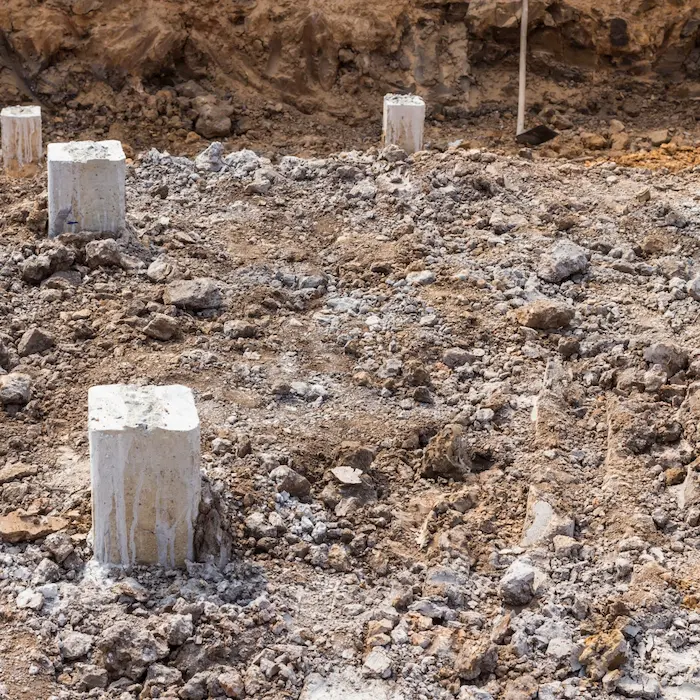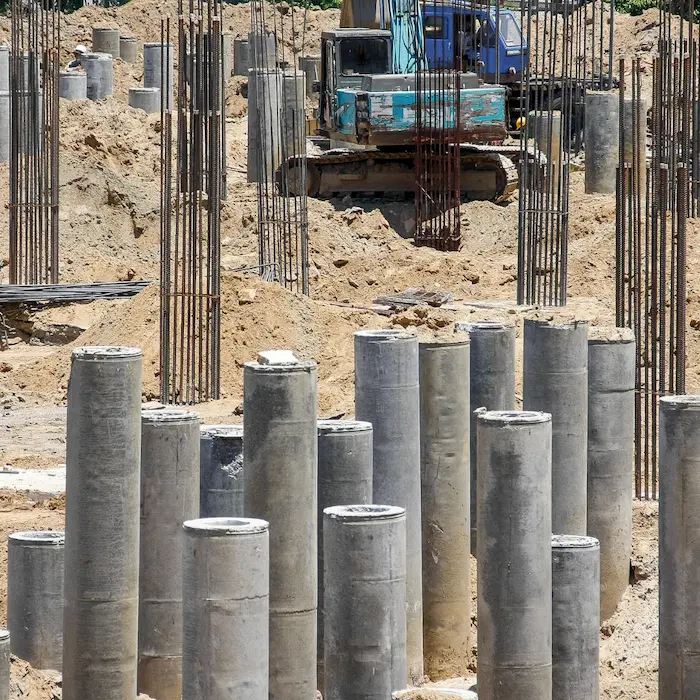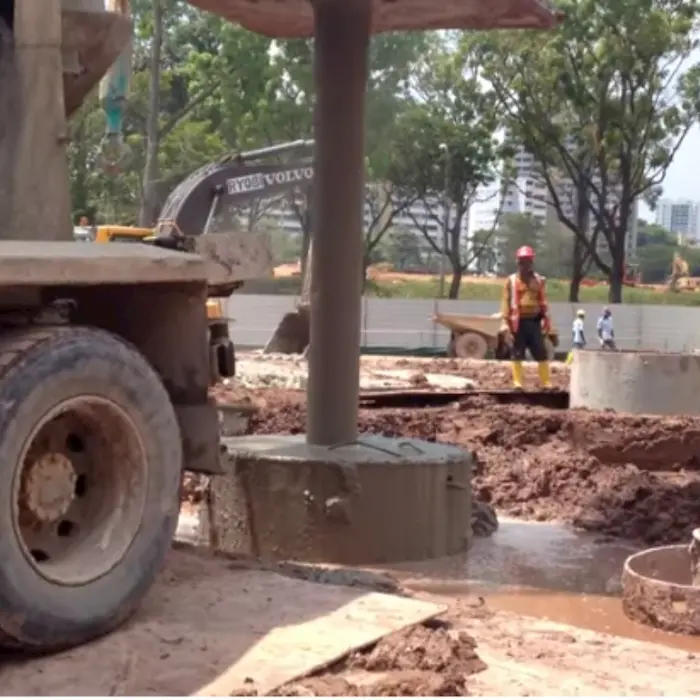If you’re looking for a foundation, you’ll find that there are many different ways to go about it. You can choose from driven piles, screw piles, bored piles, or mini piles if you want. When you’re new to the world of foundations, you might not know all the different types of piles that you can choose from. In terms of foundation type, driven piles and bored piles are the two most common types and today we will learn about the difference between driven pile and bored pile.
However, something that gets asked a lot, and that is, what’s the difference between driven piles and bored piles? Despite the fact that the driven pile and bored pile have similar functions, they also differ in a few respects. We will be covering the Difference Between Driven Pile and Bored Pile in this post, so read on to find out.
What Is Driven Pile Foundation?

Driven piles, also known as displacement piles, are an important form of the building foundation. It provides support for the structure by selecting rock or soil layers with sufficient bearing capacity and settlement characteristics to support structures and stabilize structures.
It is commonly used to support buildings, tanks, towers, walls, and bridges and is also one of the most cost-effective deep foundation solutions. Furthermore, they can be used for embankments, retaining walls, bulkheads, anchorage structures, and cofferdams.
Pile drives are highly versatile and can be installed for compression, tension, or lateral loads, depending on the structure’s requirements, budget, and soil composition. So there are some difference between driven pile and bored pile.
What Is Bored Pile Foundation?

Bored piles are reinforced-concrete foundations that support structures with heavy vertical loads. Bored piles are cast-in-place concrete piles, which means they are cast on-site. This is different from other concrete pile foundations, such as spun piles and reinforced concrete square piles, which use precast concrete piles.
This type of piling is commonly used for constructing bridges, tall buildings, and massive industrial complexes, as all of these types of structures require deep foundations that need to be bored.
Here we will discuss the difference between bored pile and driven pile in more detail.
Difference Between Driven Pile And Bored Pile
The point of manufacture is the fundamental difference between driven pile and bored pile foundation. A driven pile is manufactured off-site under factory conditions, while a bored pile is manufactured on-site.
Typically, bored pile foundations are poured into place, providing structural support by transferring the load to soil or rock layers with sufficient bearing capacity and settlement properties.
Driven piles are sometimes called displacement piles because the pile shaft enters the ground and moves soil radially when it drives into the ground. Additionally, there may be vertical movement of the soil.
Driven Pile Features:
Generally, driven piles are made out of timber or concrete, and their shape and size are determined during construction. During the installation of driven piles, the piles are literally driven into the ground by a large drop hammer which is used to install the pile. The following are some of the features of driven piles:
- Quick Installation
Since driven piles are premade before your foundation construction team arrives on-site, they will be able to be installed quite quickly once they have arrived at the site.
- Noisy
It is also very important to note that when they are installed, they are quite noisy and disruptive. Think about it – they’re being pounded into the ground with a giant hammer, and of course, they’re not going to be able to get quite silent.
- Vibrations
It is common for driven piles to cause a lot of vibration when they are driven into the ground. As a result, they can’t be used in situations where other foundations are close by, such as city centers or densely populated areas, where other foundations would clash.
Bored Pile Features:
In order to build a foundation for your construction, bored concrete piers involve drilling holes in the earth and filling them with concrete in order to support the foundation. The following are some of the features of bored concrete piers:
- Higher Capacities
A bored concrete pier typically offers greater capacity than a driven pile in many cases. Bored pile foundations are one of the strongest and most reliable methods for piling, so they’re widely used in construction.
- Enhanced Performance in Deep Sand Areas
If you are laying the foundation on an area where deep sand is present, such as a coastline, you may have to bore concrete piers in order to support your foundation. There is no doubt that bored piers can perform better in situations such as these that are deep and sandy.
- Less Noise, Fewer Vibrations
It is also one of the benefits of concrete piers that they cause less noise as well as fewer vibrations. Because of this, they are usually preferred when working in dense urban areas where it is possible for intense vibrations to cause damage to existing foundations adjacent to the project site. As a result, builders believe that it is their responsibility to look after the community by considering noise and vibration, as well as other environmental concerns.
Now let’s know the difference between bored and driven piles based on material and equipment.
Difference Between Driven Pile and Bored Pile Based on Material & Equipment
Material
Driven Piles are made from preformed material with a predetermined shape and size, which can be physically inspected prior to and during installation, and are installed by impact hammering, vibrating, or pushing into the ground. A number of materials may be used to construct these piles, including timber, steel, and precast concrete.
Essentially, bored piles are concrete piles that are cast on the construction site, meaning that they are cast in place as they are being built. Among them are Drilled Shafts, Mini Piles, Micro Piles, Drilled Displacement Piles, Sectional Flight Auger (SFA), and Continuous Flight Auger (CFA) Pile.
Equipment
Typically, driven pile construction equipment includes cranes, hammers, piling rigs, and power packs (hydraulic or air-hammer). And bore piles use drilling rigs, helper cranes, spoil handling equipment (loaders, skip pans, etc.), casing, slurry handling equipment, cage erection templates, concrete trucks, and concrete pump trucks.
Hopefully, you get a clear knowledge of the difference between driven pile and bored pile. Now let’s take a look at the advantages and disadvantages of driven pile and bored pile.
Advantages Of Driven Pile
The following are some of the benefits of using driven piles:
- As the pipes can be prefabricated off-site, they can be quickly and efficiently installed once on site.
- By displacing and compacting the soil, driven piles increase their bearing capacity. In contrast, other deep foundations can cause subsidence and other structural issues if the soil is removed.
- Due to their ability to be fabricated to specified dimensions, they can reduce the need for piles on site by using a wide variety of materials and shapes.
- The structural strength of these types of foundations is generally superior to those of other types. As a result of their high lateral and bending resistance, they are ideal for challenging conditions such as wind, water, seismic loading, etc.
- There is usually little spoil from the installation that has to be removed and disposed of.
Disadvantages of Driven Pile
There are several disadvantages to using driven piles, which include the following:
- To handle and drive heavy equipment on site, advance planning is required.
- During transportation and installation, precast or prestressed concrete piles must be adequately reinforced to withstand handling stresses.
- It may not be possible to determine the exact length required, so splicing or cutting may be required, which is time-consuming and costly.
- The use of driven piles is not recommended when the ground drains poorly.
- In compact sites, driven piles may cause vibrations that affect nearby structural foundations.
- Installing driven piles can be noisy, and vibrations may cause neighbours to complain, as they may notice pre-existing problems with their own building that they then attribute to pile vibration.
Advantages Of Bored Pile

The use of bored piles has a number of advantages, including the following:
- Extending piles of varying lengths into soft, loose, or swelling topsoil is possible by working their way through the material.
- Depending on the level of periodic dampness and frost penetration, piles can be lengthened to depths below their penetration depth.
- It is no longer necessary to excavate massively and backfill with sand and gravel.
- During the construction process, neighboring regions are less troubled.
- Bore pile foundations generate relatively little turbulence, minimizing disruption of adjacent piles or buildings.
- Large-capacity caissons can be built by extending the pile shaft three times its circumference, eliminating the need for multiple pile assemblies to be covered.
- For many design requirements, Bored Piling companies deliver higher capacities and possibly better profitability than conventional pile arrangements.
Disadvantages Of Bored Pile
There are several disadvantages to using bored piles, which include the following:
- Additional costs are associated with the removal of displaced soil.
- In extremely loose or cohesionless soils, this pile cannot be used.
- As a result of localized stress being placed on the curing material (known as waisting or necking), piles can deform.
- Coordination between multiple trades (rebar supplier, piling crew, and concrete supplier)
Final Thoughts
Finally, you have a complete idea of the difference between driven pile and bored pile. When constructing foundations, we can choose bored piles and screw piles over driven piles: they are more effective, less noisy, and less vibrational! Hopefully, you can understand the difference between driven pile and bored pile.
The experts at Legal Piling are here to help you with all things piling foundation. Legal Piling offers a wide range of world-class services at reasonable prices, including construction, repairs, and basement retrofitting. Get in touch with us today to learn which type of piling service is right for your new construction.
Frequently Asked Questions
Why driven piles is used?
In order to provide lateral support for retaining walls, driven piles are used to provide structural support. In most cases, piles are advanced to their design tip depth or nominal resistance with an impact or vibration hammer and tied together with a pile cap.
How deep are piles driven?
By using pile joints, precast concrete piles can be driven beyond 30mx. In most cases, concrete precast piles are drilled down to a depth of 30m, but they can be driven as deep as 150m in special circumstances, such as offshore projects.
What are driven piles made of?
Using a large hammer, structural elements are driven into the ground to form a “driven pile foundation.”. Timber, precast concrete, and pipes typically form driven pile foundations.
